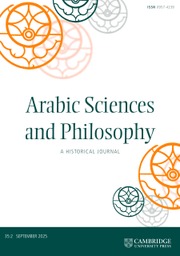Article contents
ABHARĪ ON THE LOGIC OF CONJUNCTIVE TERMS
Published online by Cambridge University Press: 05 March 2010
Abstract
The Persian philosopher Atīr al-Dīn al-Abharī (d. 1265), in his Revealing Thoughts, sketches out several different logics of propositions containing complex terms such as ‘writing man’. I will outline his results and the criticisms of them made by Naṣīr al-Dīn al-Ṭūsī (d. 1274) in his Setting the Scale for an Evaluation of “Revealing Thoughts”, and I will compare Abharī’s various logics of complex terms with modern treatments.
Résumé
Le philosophe persan Atīr al-Dīn al-Abharī (m. 1265), dans ses Pensées Révélantes, dresse le tableau de plusieurs logiques de propositions contenant des termes complexes comme ‘homme écrivant’. J’entends mettre ses résultats en lumière, ainsi que les critiques dont ils ont fait l’objet de la part de Naṣīr al-Dīn al-Ṭūsī (m. 1274), dans ses Préliminaires à une appréciation des “Pensées Révélantes”; je comparerai en outre les diverses logiques de termes complexes proposées par Abharī à des traitements modernes.
- Type
- Research Article
- Information
- Copyright
- Copyright © Cambridge University Press 2010
References
1 Aristotle, Prior Analytics Book I, translated with and Introduction and Commentary by Gisela Striker (Oxford, 2009), A14, 33a38–b3.
2 Paul Thom, The Syllogism (Munich, 1981), pp. 21–4.
3 See the Appendix, Section 1, Abharī [160.14] for translation by Tony Street.
4 Appendix, Section 2.1, Ṭūsī on Abharī1.
5 Appendix, Section 1, Abharī1.
6 Appendix, Section 2.1, Ṭūsī on Abharī1.
7 Appendix, Section 1, Abharī2 Preliminary Statement.
8 Appendix, Section 1, Abharī2 Preliminary Statement.
9 Appendix, Section 1, Abharī2 Preliminary Statement.
10 Appendix, Section 1, Abharī2 Preliminary Statement.
11 Thom, The Syllogism, pp. 125–8.
12 Appendix, Ṭūsī on Abharī2, Preliminary Statement 2.2.1.4.
13 Appendix, Ṭūsī on Abharī2, Preliminary Statement 2.2.1.
14 Thom, The Syllogism, p. 81.
15 Appendix, Ṭūsī on Abharī2, Preliminary Statement 2.2.1.
16 Appendix, Ṭūsī on Abharī2, Preliminary Statement 2.2.1.1.
17 Appendix, Ṭūsī on Abharī2, Preliminary Statement 2.2.1.1.
18 Appendix, Ṭūsī on Abharī2, Preliminary Statement 2.2.1.2–2.2.1.3.
19 Appendix, Section 1, Abharī2 with Rider.
20 Appendix, 2.2.2, Ṭūsī on Abharī2 with Rider.
21 Appendix, 2.2.2.1, Ṭūsī on Abharī2 with Rider.
22 Appendix, Section 1, Abharī3.
23 Appendix 2.3, Ṭūsī on Abharī3.
24 J.N. Keynes, Studies and Exercises in Formal Logic, including a generalisation of logical processes in their application to complex inferences, 4th edn (London, 1906), Exercise 346, p. 403.
25 Ibid., pp. 390–4.
26 A.J. Baker, “Non-empty complex terms” , Notre Dame Journal of Formal Logic, 7 (1966): 48–56, p. 48.
27 Ibid., p. 49.
28 Ibid., p. 49.
29 A.N. Prior, “Historical note” added to C.A. Meredith, “Terminal functors permissible with syllogistic”, Notre Dame Journal of Formal Logic, 10 (1969): 309–12.
30 Ibid., p. 311.
31 I thank Tony Street for making his translations of Abharī and Ṭūsī available to me, and for inspiring me to pursue this research. I also thank the Journal’s referee for numerous helpful comments.
- 6
- Cited by


